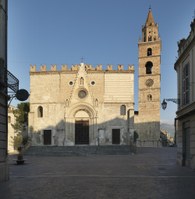St Berard’s Church
The Cathedral of Teramo (dedicated to the Assumption of the Virgin Mary) – also known as the ‘Duomo’ – begun in 1158 with Bishop Guido II and carried on in 1300 with Bishop Nicoló degli Arcioni who wanted its extension. Further changes took place the second half of 1400 and again in 1700 when the cathedral changed to reflect the artistic forms of the Baroque style (then removed in 1932). The last restoration campaign of 2007 brought to light a room under the nave, today made visible thanks to a sophisticated system of transparencies.
The cathedral boasts two façades that reflect the Romanesque and the Gothic artistic influence. The first one overlooks Orsini Square, where one can admire the latest alterations wanted by Bishop Nicoló degli Arcioni. He made substantial repair works in the upper part of the cathedral and built a subtle horizontal Ghibelline crenellation crowning.
Another important artwork of the façade is without any doubts the unique main entrance door of 1332. A round wood portal made in 1911 by Cavicchioli that opens the façade at the centre. The decoration of the tympanum that surmounts it is one of the most evocative examples of Cosmati art. The ample frieze embellished with mosaics is the most defining element of this art, here emphasised by six thin stone columns. Four of them are spiral, whereas the outer two are round, smooth and as pedestals have two magnificent crouched down lions.
The façade overlooking Martiri della Libertá Square is plainer and more basic; it displays a narrative stained-glass window, another one above and finally two more on both side and lower down. At the top of the staircase stands out the blind door never opened, and only meant to embellish the façade.
The imposing interior portrays a three-nave ground plan, each leaning on columns supporting round arches. The silver Paliotto - altar frontal - by Nicola da Guardiagrele (1433- 1448), stands out among other ornaments for its value. The altar frontal tells the story of Jesus Christ and depicts other holy scenes through a series of finely hammered silver plates. Also remarkable is the fifteenth-century polyptych of Saint Augustine by the Venetian Jacobello del Fiore. It is made of sixteen boards, framed and divided into two parallel sequences and at its centre there is a depiction of Christ crowing the Virgin Mary. Similarly beautiful is the ceiling with wood-trusses on sight and ancient ornamental patterns. The light coming through the long single lancet windows gives a break from the rigour of the interior.
The wooden Baroque-style choir is visible right at the other end from the entrance; of the same style is Saint Berard’s chapel which preserves his urn. At the foot of the presbytery’s staircase, on the right, there is a superbly made pulpit, whereas on the left, one can observe an Easter candelabra of great value. At its interior, the church presents a silver altar frontal – known as Paliotto d’argento - that depicts the story of Jesus; this also features other holy scenes through a series of finely hammered silver plates, realized from 1433 to 1448.
The cathedral also can claim the most beautiful Gothic-style bell tower of Abruzzo by the Lombard School. Its upper part is the most important for a composition of decorations with enamelled terracotta discs in yellow and turquoise. The bell tower presents three different styles: the base and the first three sections of the pedestal were built between the twelfth and thirteenth century. Further two sections were built in the fourteenth century and finally the octagonal pyramid in the fifteenth century. At the base of this pyramid were erected eight small towers on each corner; a golden copper ball surmounted by a wrought iron cross with pennon was installed above the cusp.
